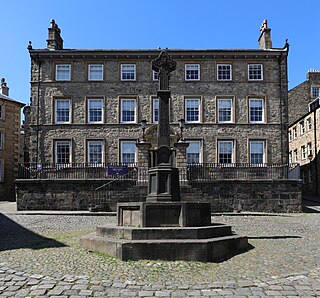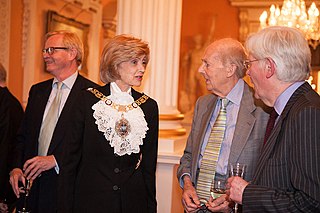
William Henry Cavendish Cavendish-Bentinck, 3rd Duke of Portland, was a British Whig and then a Tory politician during the late Georgian era. He served as Chancellor of the University of Oxford (1792–1809) and twice as Prime Minister of Great Britain (1783) and then of the United Kingdom (1807–1809). The gap of 26 years between his two terms as Prime Minister is the longest of any British Prime Minister. He was also the fourth great-grandfather of King Charles III through his great-granddaughter Cecilia Bowes-Lyon, Countess of Strathmore and Kinghorne.

William John Cavendish-Scott-Bentinck, 5th Duke of Portland, styled Lord John Bentinck before 1824 and Marquess of Titchfield between 1824 and 1854, was a British Army officer and peer, most remembered for his eccentric behaviour. A recluse who preferred to live in seclusion, he had an elaborate underground maze excavated under his estate at Welbeck Abbey near Clumber Park in North Nottinghamshire.
George Hepplewhite was a cabinetmaker. He is regarded as having been one of the "big three" English furniture makers of the 18th century, along with Thomas Sheraton and Thomas Chippendale. There are no pieces of furniture made by Hepplewhite or his firm known to exist but he gave his name to a distinctive style of light, elegant furniture that was fashionable between about 1775 and 1800 and reproductions of his designs continued through the following centuries. One characteristic that is seen in many of his designs is a shield-shaped chair back, where an expansive shield appeared in place of a narrower splat design.

Baker Street is a street in the Marylebone district of the City of Westminster in London. It is named after builder William Baker, who laid out the street in the 18th century. The street is most famous for its connection to the fictional detective Sherlock Holmes, who lived at a fictional 221B Baker Street address on the north of the street. The area was originally high class residential, but now is mainly occupied by commercial premises.
Robert Gillow (1704–1772) was an English furniture manufacturer, who founded Gillow & Co.
Waring & Gillow was a noted firm of English furniture manufacturers and antique dealers formed in 1897 by the merger of Gillows of Lancaster and London and Waring of Liverpool.

Ince and Mayhew were a partnership of furniture designers, upholsterers and cabinetmakers, founded and run by William Ince (1737–1804) and John Mayhew (1736–1811) in London, from 1759 to 1803; Mayhew continued alone in business until 1809. Their premises were located in Marshall Street but were listed in London directories in Broad Street, Soho, 1763–83, and in Marshall Street, Carnaby Market, 1783–1809. The partnership's volume of engraved designs, The Universal System of Household Furniture, dedicated to the Duke of Marlborough, was issued in imitative rivalry with Thomas Chippendale; Ince, who was a subscriber to the first edition of Chippendale's Director, was chiefly responsible for the designs, while Mayhew contributed the greater part of the partnership's capital, kept the accounts, and was in closer contact with the firm's clientele among the nobility and gentry. The name of the firm originally appears to have been "Mayhew and Ince", but on the title page of The Universal System the names are reversed, suggesting that Ince was the more extensive contributor.

Winifred Anna Cavendish-Bentinck, Duchess of Portland was a British humanitarian and animal welfare activist.
Mallett Antiques is an "antiques" dealer with galleries in London and New York who regularly exhibit at the International Fine Art & Antique Fairs.
William France Sr. was born in the small agricultural village of Whittington, six miles north of Lancaster, where he was christened on 7 January 1727 the second son of Edward, a yeoman farmer, and Agnes France. His elder brother, John, was christened on 27 March 1725 and was apprenticed to a cabinetmaker in Lancaster where he married Elizabeth Townson the daughter of John Townson, a joiner, in 1747.

William France Jr. was a cabinetmaker and upholsterer in 18th century London and a member of the well known France family who held the Royal Warrant for over half a century. He was the nephew of William France Sr. and younger brother of Edward France, the former being cabinetmaker to the Royal Household. He was born in 1759 and died in 1838 in Boulogne, France. He was made a Freeman of Lancaster in 1785–86.

The Judges' Lodgings, formerly a town house and now a museum, is located between Church Street and Castle Hill, Lancaster, Lancashire, England. It is recorded in the National Heritage List for England as a designated Grade I listed building. The building is the oldest existing town house in Lancaster, and was also the first house in Lancaster to have shutters. It was used by judges when they attended the sessions of the Assize Court.

Hamptons is an estate agent that has a UK network of more than 93 branches and an international affiliate partner network of over 7,000 offices. Hamptons' parent company, Countrywide, was acquired by The Connells Group in April 2021.

Sir Nicholas Proctor Goodison was a British businessman who was chairman of the London Stock Exchange from 1976 to 1986. He was an important supporter of the arts and the President of the Furniture History Society (FHS).

Gillows of Lancaster and London, also known as Gillow & Co., was an English furniture making firm based in Lancaster, Lancashire, and in London. It was founded around in Lancaster in about 1730 by Robert Gillow (1704–1772).

The Lady's workbox in the Judges' Lodgings Museum, Lancaster, was made in 1808 in Lancaster by Gillows.
Maple & Co. was a British furniture and upholstery manufacturer established in 1841 which found particular success during the Victorian and Edwardian eras. The company became one of the prime makers and suppliers of furniture to the aristocracy and royalty in both the United Kingdom and around the world.
The firm of Holland & Sons (1803–1942) became from 1843 one of the largest and most successful cabinet makers, and a rival to Gillows of Lancaster and London.
William Trotter of Ballindean JP DL (1772–1833) was a Scottish cabinet-maker who served as Lord Provost of Edinburgh from 1825 to 1827.
Howard & Sons is a furniture maker in London, England. The main address was at Berners Street 25–27.













